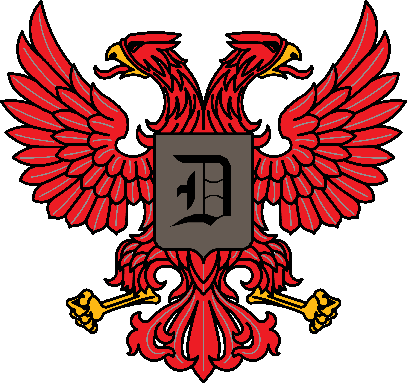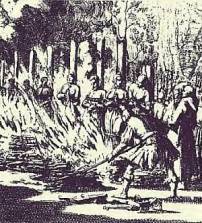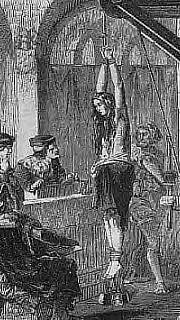
Eachdraidh Dunlop

Footprints of the Clan
Here be True Histories of our namesakes...
Read...and walk with them through the pages of Time.
How a Dunlop came to be burnt at the
Stake...for Witchcraft

The flame tuik fast upon her cheik
Tuik fast upon her chin;
Tuik fast upon her faire bodye -
She burn'd like hollins green.
Traditional Ballad by Earl Richard
According to Ehrenreich and English, witches'
crimes fall roughly into three categories: organization, female sexuality, and
healing.
Witches were accused of gathering together to
bring about evils and various events. Some women still celebrated the old folk
religions with music and rituals outside the Church and met for fellowship.
Certainly other news would have been passed along at these gatherings, including
news of political interest. These organizations were seen as subversive
activities, undermining the sovereignty of the Church. So part of the witches'
crime became socially organizing.
A second crime was acknowledging and embracing
sexuality. A witch supposedly used her sexuality to do harm to men. Under the
old ways, sexuality was a gift. Under the Church's view, sexuality became a sin.
Beginning with Eve, women were seen as the root of mans' fall from grace.
Husbands were urged by the clergy to beat their wives "for charity to her soul".
According to the
Malleus Maleficarum, all witchcraft came from women's insatiable
carnal lust, expressed by witches' sexual relations with the Devil. They also
bewitched men and cast spells that made men's sexual organs disappear.
The third general category of witches' crimes
is healing, perhaps the most interesting and unexpected of the charges. How did
healing and relieving pain and suffering become a target of these witch hunts?
In rural areas where the witch burnings occurred, wisewomen had long been called
on to comfort and heal. They used plants and herbs to cure in the tradition of
the Earth Goddesses that had been celebrated across many cultures. Williams &
Adelman explain that unmarried or widow women who could not support themselves
in other ways often claimed powers to cure animals or humans in return for bare
sustenance.
Women healers challenged the Church's position
that the ability to cure, thus the powers of life and death, lay exclusively in
the hands of God and his earthly emissaries (i.e., male priests). Midwives were
especially dangerous. They eased the pain of labor, God's punishment to all
women for Eve's sin. And they went against God's will in practicing birth
control and abortion. Midwives offered newborns to the Devil. In an age when any
complications in childbirth could readily lead to death, safe childbirth could
be blamed on the witch midwives' supernatural powers. A death could be blamed on
her evil work.
These folk remedies were also outside the law
and university medical "knowledge" of the period. Women who professed to heal
without studying medicine were considered lawbreakers, even though women were
not allowed into medical schools and the medical schools had nothing better to
offer. The Church and physicians (many from the Catholic elite) were not able to
stop the illnesses and deaths brought by
Black Death and the epidemics that followed. Much to the disapproval of the
ruling elite in church, state, and medicine, people turned to wise women for
help since the Church wasn't helping them. The Church also perceived this as a
challenge to its' authority. Although university trained physicians had no
better knowledge of controlling illness than these laywomen, the testimony of
male doctors was used against many accused witches. Physicians could reputedly
tell if an illness was from witchcraft or a biological cause. For example, an
illness resulting from witchcraft could not be relieved by drugs (conveniently
excusing the physician from any accountability for his own inability to bring
relief).
-- Kathy S. Stolley
Although literally thousands of people were
burned throughout Europe for being convicted of these crimes the situation in
Britain was comparatively mild to the Continent, for these beliefs spread slowly
and in crossing the Channel they lost much of their potency.
The practise of burning witches was never really adopted in England although
direct dissenters with the established religion were treated as heretics and
then burned (not much better). Witches were burned in Scotland and, again unlike
England, torture was used to gain confessions of guilt from them.
Not only was much of the potency of the witch-hysteria in Europe lost in
reaching Britain, but it arrived at a later date and the type of heretic-witch
who was constantly pursued by the Inquisition in Europe was virtually unknown in
Scotland, until a law was passed against them by Mary Queen of Scots in 1563.
Mary was the wife of the Dauphin of France and
inherited the throne of Scotland on the death of her mother (Mary of Guise). She
brought many European ideas with her and her Act was based on the assumption
that witchcraft equated with heresy, hence burning became the prescribed
punishment for a traitor, a heretic or a witch -- but not for a murderer.
At the same time the Scottish Reformation was
taking place. The Protestant John Knox lived to see the Catholic Queen Mary lose
her power -- she flew to England, Elizabeth I and her death -- but the
punishment of witches remained the same under the reformed church and the
persecution of witches was carried out with more thoroughness than before.
Although witch-hunting in Scotland continued sporadically between about 1500 and
1700, there were three main peak-periods of activity, 1590-97, 1640-44 and
1660-63.
Ayrshire and Famous Cases:
It was proved against John Cunningham, that the devil appeared to him in white
raiment, and promised that, if he would become his servant, he would never want,
and should be revenged of all of his enemies. It was further proved, that he
(the prisoner) "...raised the wind on the king's passage to Denmark: that he met
with Satan on the king's return from Denmark, and Satan promised to raise a
mist, by which his majesty should be thrown up on the coast of England; and
thereupon threw something, like a football into the sea, which raised a vapour."
He was condemned and burned.
Euphan M'Calzeane, daughter of Lord Cliftonhall, one of the senators of the
college of justice (his death, in 1581, spared him from the disgrace and misery
of seeing his daughter fall by the hands of the executioner), who was married to
a gentleman, by whom she had three children, was accused of treasonably
conspiring the king's death by enchantments; particularly by framing a waxen
picture of the king (king James VI); "... of raising storms to hinder his return
from Denmark" ; and of various other articles of witchcraft. She possessed a
considerable estate in her own right; was heard by counsel in her defence; was
found guilty by the jury, which consisted of landed gentlemen of note; and was
"burnt alive", and her estate confiscated. Her children, however, after being
thus barbarously robbed of their mother, were restored by the act of parliament,
against the forfeiture. The act does not say the sentence was unjust, but the
king was " touched in honour and conscience" to restore the children. But, to
move his majesty's conscience, the children had to pay five thousand merks to
the donator of escheat, and relinquish the estate of Cliftonhall, which the king
gave to Sir James Sandilands of Slamanno.
And lastly, and more important to us, was
Bessie Dunlop, a healer and Wisewoman of East Ayrshire. Bessie was a
midwife and gifted/cursed with the “powers of Healing”. Accused of Witchcraft
by male neighbors on November 8th, 1576, she was arrested and taken
to Edinburgh, where she would become a famous case of the Court of Justiciary.
Bessie was tortured by “hanging her by her thumbs, holding her soles of her feet
to fire,, burning of them, until she wouldst confess”.
 She
claimed that the Queen of Fairies (ElfHane) had visited her during childbirth,
and demanded a drink of water. Dunlop gave her one, although she was in extreme
pain. In reward, the Queen Fairie had ordered the spirit of Thome Reid, a
soldier who had died in battle on September 10, 1547, to serve Bessie Dunlop.
Thome taught Bessie how to heal and how to tell the future. He would appear to
Bessie whenever she called out his name three times. Over the period of four
years, Thome requested repeatedly that Bessie denounce the Christian Faith,
which she steadfastly refused to do. She repeatedly asserted that she had always
used her powers for good, having healed many of the people then in East Ayrshire.
No one would step forward to speak for her, fearing also for their own lives.
Hideous torture followed for three days, during which time Bessie never changed
her story. She was taken to Castle Hill, strangled and then burnt alive in
front of a huge crowd. Her possessions were seized by the Court and sold.
She
claimed that the Queen of Fairies (ElfHane) had visited her during childbirth,
and demanded a drink of water. Dunlop gave her one, although she was in extreme
pain. In reward, the Queen Fairie had ordered the spirit of Thome Reid, a
soldier who had died in battle on September 10, 1547, to serve Bessie Dunlop.
Thome taught Bessie how to heal and how to tell the future. He would appear to
Bessie whenever she called out his name three times. Over the period of four
years, Thome requested repeatedly that Bessie denounce the Christian Faith,
which she steadfastly refused to do. She repeatedly asserted that she had always
used her powers for good, having healed many of the people then in East Ayrshire.
No one would step forward to speak for her, fearing also for their own lives.
Hideous torture followed for three days, during which time Bessie never changed
her story. She was taken to Castle Hill, strangled and then burnt alive in
front of a huge crowd. Her possessions were seized by the Court and sold.
The famous site at Castle Hill is one where
current tours will tell of many nameless women being tortured, strangled and
burnt for Witchcraft. For us, it has a much deeper meaning.
The Footsteps of our Clan walk through the
inquisitioner’s court, through the torture chamber…………………………… and into the fire
of a medieval Hell.
![]()
![]()
